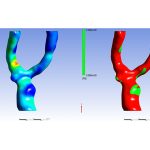
AI in personalized medicine: Better risk detection, prevention and treatment of carotid stenosis | TAXINOMISIS Project | Results in brief | H2020 | CORDIS

Carotid stenosis is caused by the narrowing or blockage of the carotid artery due to plaque buildup (atherosclerosis). Current screening for asymptomatic carotid stenosis, stroke prevention and disease management are based on the European Society of Vascular Surgery’s 2017 Good Practice Guide. However, clinical decision-making is complicated by the variability of the disease, requiring more personalized treatments.
AI-based patient stratification strategy
The main objective of the EU-funded TAXINOMISIS project is to create a novel model that can categorize affected individuals based on their risk of developing carotid stenosis and suffering cerebrovascular events such as stroke, transient ischemic attack or temporary vision loss. The model will enable healthcare professionals to make more informed decisions about patient care and treatment, thereby improving clinical outcomes. “TAXINOMISIS has designed a rational new approach to address the key clinical gaps on carotid stenosis in terms of predicting progression, need for follow-up and selecting appropriate interventions,” explains project coordinator Dimitrios Fotiadis. The model includes AI-based modules/components that integrate clinical information and personalized patient data, plaque and brain images as well as blood flow patterns and new biomarkers. Computer models and simulations predict silent brain lesions, cardiovascular events, plaque firmness, and plaque formation and rupture.
Machine learning to predict carotid stenosis
The TAXINOMISIS risk stratification tool is designed to assess the risk of carotid stenosis in individuals by using non-imaging data as input to evaluate the likelihood of plaques at risk and the potential development of the disease. The tool also offers additional features: it links the condition of the carotid artery to the presence of brain lesions and predicts the risk of new brain lesions. In addition, the tool includes a blood flow component used to predict the risk of plaque progression and is also used as an event prediction model. In addition, the tool can estimate the risk of plaque rupture, a first event associated with blood clots in the blood vessels. The tool estimates the risk of rupture using two different models – a complex model that takes into account various factors related to both the structure of the artery wall and the composition of the plaque itself, and a simplified model that focuses only on the interior of the artery, called the lumen. This allows healthcare professionals to choose the appropriate level of analysis depending on the available data, resources and clinical context. Finally, the TAXINOMISIS risk stratification tool uses advanced AI techniques to reconstruct the 3D geometry of arteries and characterize plaques from magnetic resonance and ultrasound imaging data.
Added value of AI in patient care
“We expect that the TAXINOMISIS risk stratification tool will improve the efficiency and quality of the entire healthcare system for treating carotid stenosis,” explains Prof. Fotiadis. Healthcare professionals can also use the risk stratification tool to understand the underlying mechanisms of the disease, which could ultimately lead to better treatment plans. The TAXINOMISIS tool will speed up the diagnostic process and reduce the need for invasive tests and treatments. This will also contribute to lower healthcare costs. Using feedback from healthcare professionals and users, as well as data from clinical trials and real cases, the team will continue to improve the platform’s algorithms and models. Joint ventures or collaborations with other organizations will be crucial to integrate the TAXINOMISIS tool into healthcare systems or combine it with other available tools. “We envision the TAXINOMISIS tool being integrated into daily clinical practice and improving clinical decision-making through accurate risk stratification,” concludes Prof. Fotiadis.
key terms
TAXINOMISIS, carotid stenosis, AI, artificial intelligence, brain lesion, patient stratification, stroke, biomarker, blood flow, plaque rupture, hemodynamics
Project information
TAXINOMISIS
Grant agreement ID: 755320
Open in new windowProject completed
EC signature date
22 November 2017
Start date 1 January 2018
End date 31 December 2023
- SOCIETAL CHALLENGES – Health, demographic change and well-being
total cost € 5 999 402.50
EU contribution € 5 999 402.50
PANEPISTIMIO IOANNINON
Greece
This project is mentioned in …

Ethel Purdy – Medical Blogger & Pharmacist
Bridging the world of wellness and science, Ethel Purdy is a professional voice in healthcare with a passion for sharing knowledge. At 36, she stands at the confluence of medical expertise and the written word, holding a pharmacy degree acquired under the rigorous education systems of Germany and Estonia.
Her pursuit of medicine was fueled by a desire to understand the intricacies of human health and to contribute to the community’s understanding of it. Transitioning seamlessly into the realm of blogging, Ethel has found a platform to demystify complex medical concepts for the everyday reader.
Ethel’s commitment to the world of medicine extends beyond her professional life into a personal commitment to health and wellness. Her hobbies reflect this dedication, often involving research on the latest medical advances, participating in wellness communities, and exploring the vast and varied dimensions of health.
Join Ethel as she distills her pharmaceutical knowledge into accessible wisdom, fostering an environment where science meets lifestyle and everyone is invited to learn. Whether you’re looking for insights into the latest health trends or trustworthy medical advice, Ethel’s blog is your gateway to the nexus of healthcare and daily living.



